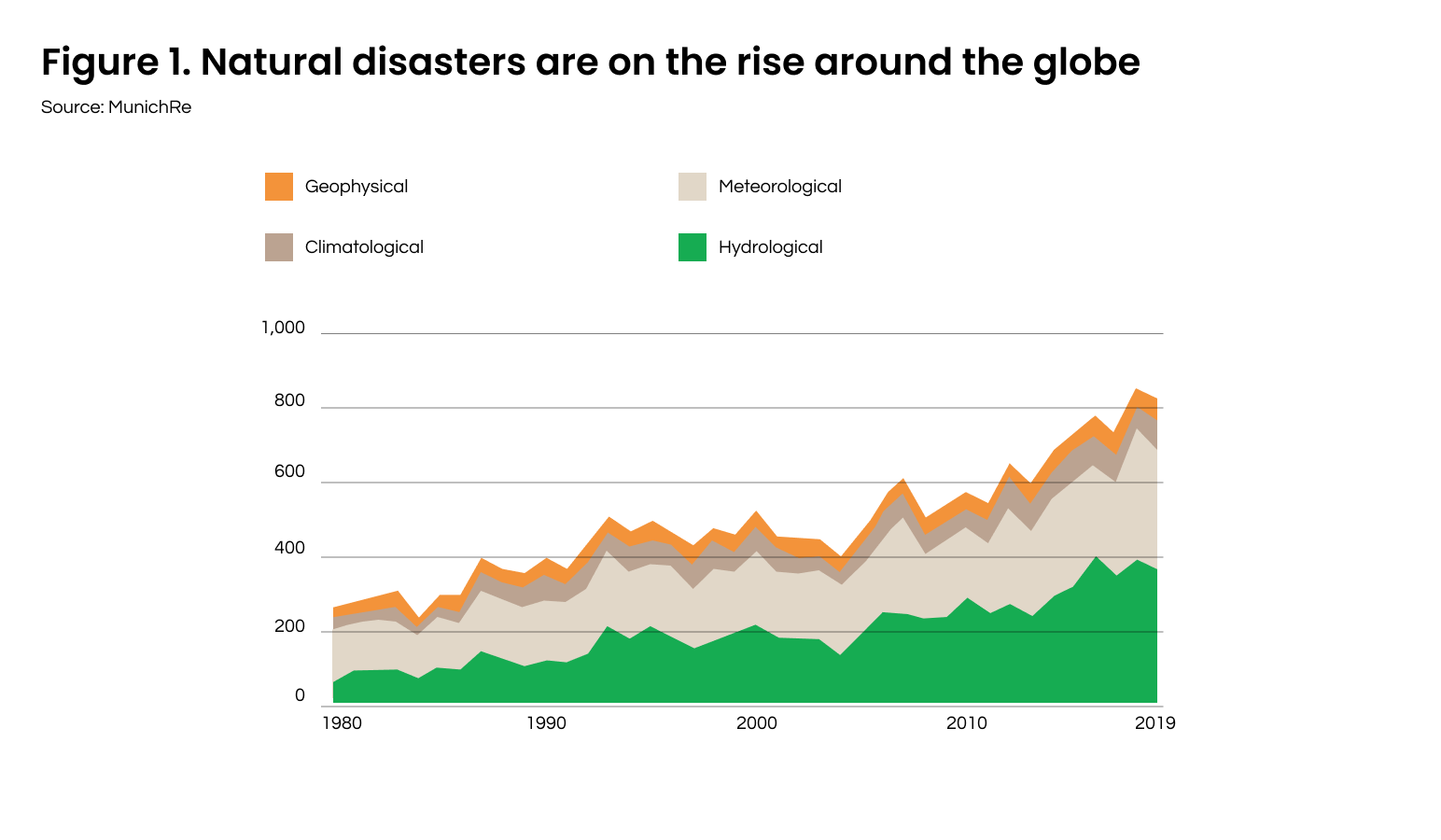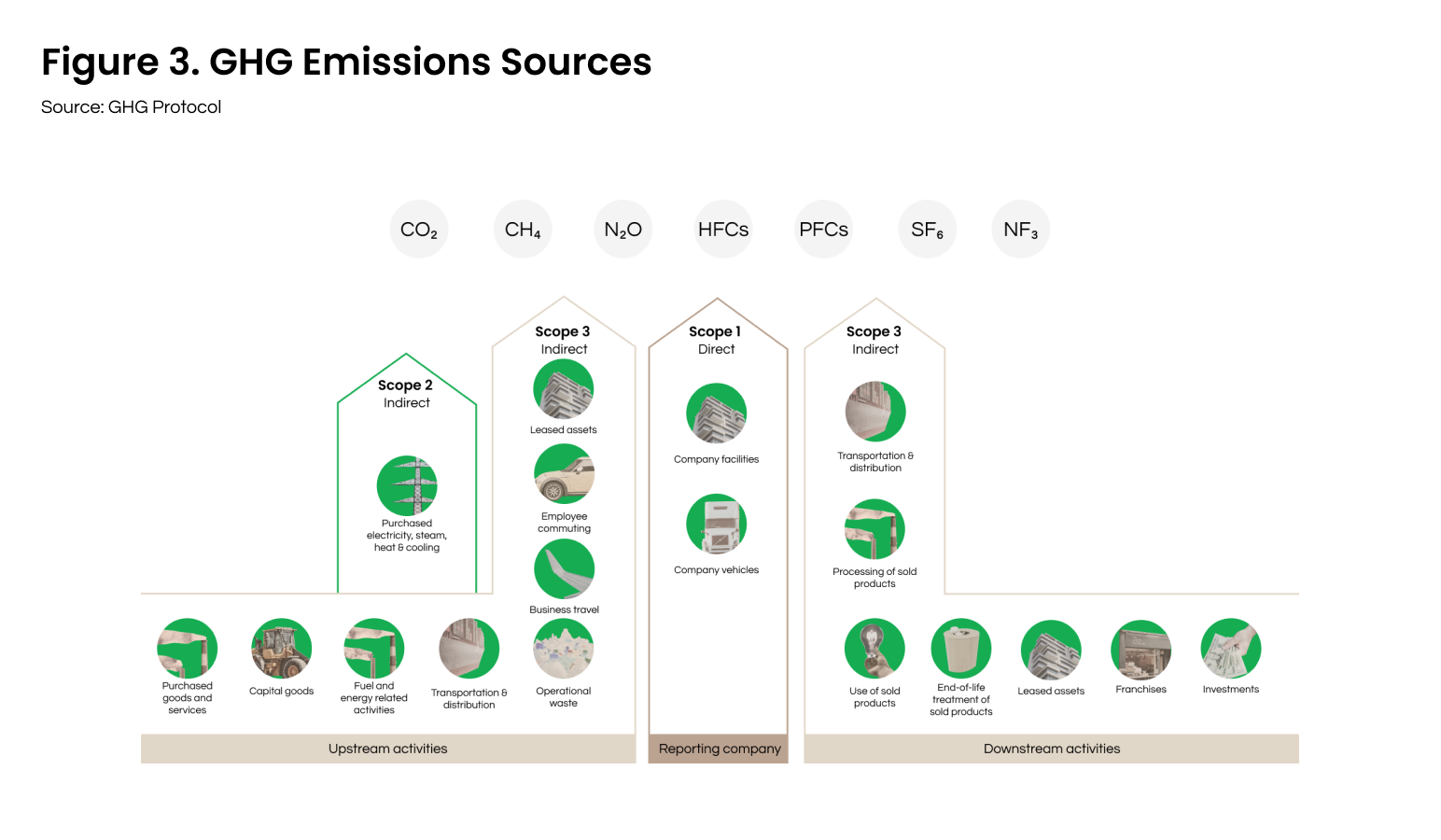Measuring GHG Emissions

Climate change risks and opportunities for businesses
Climate change is impacting our societies at an alarming rate. Whereas at the beginning of this millennium it was still an abstract concept for many, nowadays its effects are showing more and more drastically. Human activities have caused atmospheric greenhouse gas concentrations to rise at an unforeseen rate.
Consequently, the average global temperatures have continued to rise, leading to the past seven years being the hottest on record. Global sea-level rise has nearly doubled in the last century. More than 10 million hectares of forests are lost every year to deforestation. The resulting impacts are in many ways detrimental to both our planet and to humanity.
Climate-related disasters, mostly caused by extreme weather events, flooding, and drought, have increased from 3,656 in the 1980-1999 period to 6,681 in the 1990-2020 period – by more than 80 %. In the past 10 years, climate-related disasters have impacted 3.2 billion people globally and resulted in US$2.97 trillion in economic losses. Needless to say, drastic measures are needed to halt this alarming progress.

Under the Paris Agreement, the world agreed to halt global warming at 1.5°C or well below 2°C above pre-industrial levels to limit the dangerous effects of climate change. Currently, the global average temperature is almost 1.2°C above the pre-industrial levels. The goals set by the global community can only be reached if all actors – governments, individuals, and companies – make a tangible change.
The private sector has an important part to play and doing so is in any business’ best interest. According to United Nations Global Compact, the global business community has up to US$24 trillion per year worth of assets at risk of climate change. These risks are not only created by the physical impacts of climate change, but also by market changes and new policy and legal measures. Governments will continue to step in to manage emissions and avert and adapt to climate change.
One such measure is carbon pricing through emissions trading schemes (ETS) and carbon taxation. The EU has already adopted its supranational trading scheme to put a price on carbon. In 2020, there were 61 carbon pricing initiatives implemented or planned all over the world, with the number expected to grow in the future. In addition to putting the burden of cost on heavy emitters, more and more governments are looking to make reporting and verification of emissions mandatory and cover larger shares of companies’ operations.
For example, according to the UK’s new reporting obligation to companies, reporting energy use and greenhouse gas emissions has become mandatory. In addition to this, climate-related legal action has seen a significant upwards trend in past years. Globally just over 800 legal cases were filed between 1986 and 2014, with over 1,000 cases being brought in the last six years. 
Understanding these climate-related risks is vital for mitigation. Failure to do so can lead to
- Severe disturbances in business operations;
- Disrupts in supply chains;
- Litigations;
- A loss of customers to more climate-responsible competitors;
- And thus decreased profitability.
Additionally, understanding the impacts of climate change on your industry allows you to seize opportunities related to the global shift to a low-carbon economy and improve your market position. Climate change strategies are increasingly more important as part of good business practices. Companies can no longer afford to not react.
Climate strategy and the importance of measuring emissions
To prepare for future changes brought in by climate change, it is essential for any business to develop a solid strategy. In its essence, it is a set of policies, commitments, and actions embedded in the company’s overall strategy to mitigate risks from climate change.
A strong climate strategy:
- Includes actions to measure emissions from operations.
- Includes actions to effectively decarbonise operations and supply chains.
- Recognises and mitigates climate change risks.
- Identifies opportunities to gain advantage from climate-related market prospects.
- Includes actions to raise awareness among stakeholders throughout the entire value chain.
It is also important to align your strategy with stakeholder expectations and ambitions. This is an excellent opportunity to increase trust and engagement. Efficient climate efforts require companies to reduce emissions not only from their own operations but also from their value chains.
To create an effective strategy and set goals for the future, you must first understand where your company currently stands regarding its climate change contribution. Therefore, it is essential to know where your emissions come from. Measuring the current emissions of the company is the cornerstone of a solid business climate strategy.
After all, you can only effectively reduce your emissions and set credible reduction goals if you know where your emissions come from. It allows you to identify your main sources of emissions and effectively focus your decarbonisation efforts on them.
This way your climate strategy has the strongest possible impact. Furthermore, regular measuring and monitoring of emissions guarantee the functionality of your chosen strategy and decarbonisation efforts. This creates a strong foundation for easier management and reporting of emissions in the long run.
Challenges and value of measuring emissions
Quantification of a company’s carbon footprint is one of the first obstacles to creating a successful climate strategy. Most companies lack in-house knowledge on calculation methodologies and awareness of the sources of their greenhouse gas emissions.
Additionally, gathering correct data can be challenging and time-consuming. This is often a result of insufficient data tracking systems or a lack of communication between different departments. Sometimes even the whole purpose of measuring can be unclear.
Measuring emissions does, however, offer many valuable benefits that make overcoming these challenges worthwhile. Proactively calculating and reporting your company’s carbon footprint can improve your reputation and offer a competitive advantage by signalling your transparency and commitment to climate actions to stakeholders and the public.
Moreover, it helps you stay ahead of future obligatory reporting requirements and helps mitigate financial risks related to future carbon restrictions and taxation. Improved awareness within the company can also have great impacts, such as increased employee satisfaction and process improvements.
Not only does measuring offer great insight on your company’s operations and their impact on the surrounding world, but emission reduction strategies can even be a great financial investment. After all, reducing energy consumption and investing in renewable energy and efficiency are ways to cut both operating costs and emissions.
How to collect data and measure emissions
Many standards and methodologies exist for carbon accounting and choosing the right one can seem confusing. It’s always important to follow the chosen standard’s requirements and guidelines to guarantee accuracy and transparency in reporting. The most widely used and recognised standard is the Greenhouse Gas Protocol (GHGP), developed by the World Resources Institute (WRI) and the World Business Council for Sustainable Development (WBCSD). The GHGP is considered the gold standard framework for measuring and reducing emissions worldwide.
For structure and clarity to understand one’s carbon footprint, The GHGP groups emissions under three scopes. Understanding these categories is essential for accurate measuring of a company’s carbon footprint.
- Scope 1 - direct emissions from owned or controlled sources;
- Scope 2 - indirect emissions from the generation of purchased electricity, steam, heating, and cooling;
- Scope 3 - all other indirect emissions that occur throughout a company’s value chain, which are split into 15 different categories. These include business travel, upstream and downstream transportation and distribution, capital goods, and processing of sold products.
A corporate carbon footprint does not only include carbon dioxide (CO2) but the sum of all greenhouse gas emissions that are released as a result of a company’s operations. In addition to CO2, these include methane, nitrous oxide, sulfur hexafluoride, nitrogen trifluoride, and the group's hydrofluorocarbons and perfluorocarbons. The greenhouse gases that make up the carbon footprint, as well as the sources of emissions categorized under the three scopes are shown in the figure below. 
For reporting purposes, scopes 1 and 2 are always mandatory in any climate reporting standard. Scope 3 is optional but highly recommended to account for, as for many companies scope 3 presents a large share of their total carbon footprint. The inclusion of scope 3 categories is based on relevance. According to the GHGP, scope 3 categories are relevant if the emissions from the category:
- Are believed to be large compared to scope 1 and 2 emissions.
- Present a risk to the company through, for instance, legislation.
- Are deemed critical by stakeholders.
- Can be influenced and reduced by the company.
It’s good practice to include as many scope 3 categories as possible and continuously expand your emissions inventory. As scope 3 involves much of the company’s value chain, it is important to engage with suppliers and customers for more accurate data.
Conclusion
With the growing pressure from stakeholders and the surrounding society to decarbonize the corporate sector, it has never been more important to be aware of your company’s carbon footprint. To meet the global reduction targets and limit the effects of climate change, impactful actions are expected from the corporate sector.
Measuring and reporting your company’s emissions creates a foundation for your climate strategy. It helps you understand what is needed to not only comply with new policies and regulations but become a climate leader in your industry.
As the awareness of consumers and other stakeholders grows, climate responsible companies can make a positive impact on the world around them. This does not have to go at the cost of financial benefits. Organisations can secure new market opportunities and switch towards more economical operations.
Future-proofing your company starts with measuring your emissions. The next step? Setting targets and reducing them.
Our next blog will cover more on setting short-, medium-, and long-term targets, as well as aligning them with the Paris Agreement and stakeholder expectations. Or get in touch with our experts at Nexio projects and start your climate journey.
We can assist you in measuring your carbon emissions, offer insight into their sources, compare you to industry peers, and give recommendations to effectively reduce your emissions. Additionally, we can guide you in creating a climate strategy by analysing the climate-related risks and opportunities facing your company and industry.